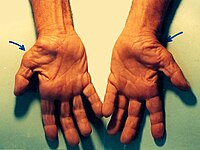
Photo from wikipedia
Residual symptoms indicating incomplete remission of lower leg numbness or low back pain may occur after spine surgery. The purpose was to elucidate the pattern of residual symptoms 5 years… Click to show full abstract
Residual symptoms indicating incomplete remission of lower leg numbness or low back pain may occur after spine surgery. The purpose was to elucidate the pattern of residual symptoms 5 years after minimally invasive lumbar decompression surgery using a cluster analysis. The study comprised 193 patients with lumbar spinal stenosis (LSS) (108 men, 85 women) ranging in age from 40 to 86 years (mean, 67.9 years). Each patient underwent 5-year follow-up. The Japanese Orthopedic Association score and visual analog scale scores for low back pain, leg pain, and leg numbness at 5 years were entered into the cluster analysis to characterize postoperative residual symptoms. Other clinical data were analyzed to detect the factors significantly related to each cluster. The analysis yielded four clusters representing different patterns of residual symptoms. Patients in cluster 1 (57.0%) were substantially improved and had few residual symptoms of LSS. Patients in cluster 2 (11.4%) were poorly improved and had major residual symptoms. Patients in cluster 3 (17.6%) were greatly improved but had mild residual low back pain. Patients in cluster 4 (14.0%) were improved but had severe residual leg numbness. Prognostic factors of cluster 2 were a short maximum walking distance, motor weakness, resting lower leg numbness, cofounding scoliosis, and high sagittal vertical axis. This is the first study to identify specific patterns of residual symptoms of LSS after decompression surgery. Our results will contribute to acquisition of preoperative informed consent and identification of patients with the best chance of postoperative improvement.
Journal Title: European Spine Journal
Year Published: 2021
Link to full text (if available)
Share on Social Media: Sign Up to like & get
recommendations!